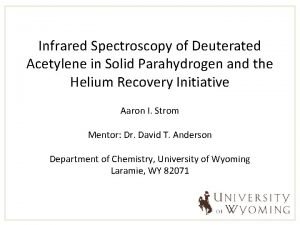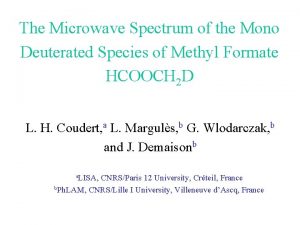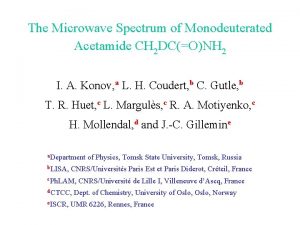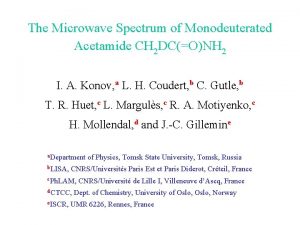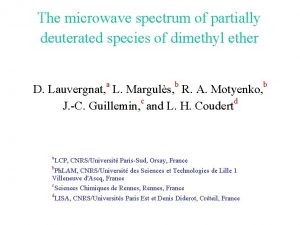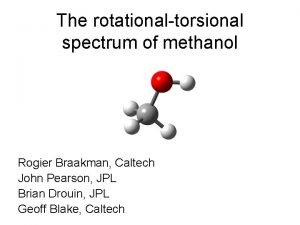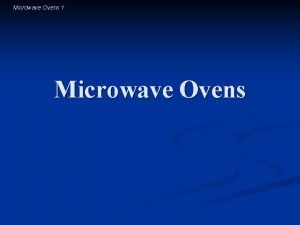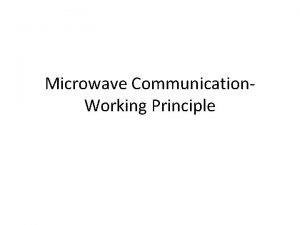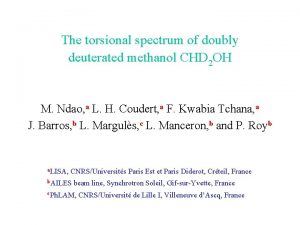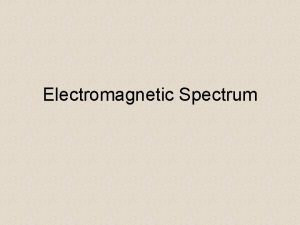The rotationaltorsional microwave spectrum of mono deuterated acetamide



















- Slides: 19

The rotational-torsional microwave spectrum of mono deuterated acetamide L. H. Coudert, H. Møllendal, and J. -C. Guillemin

Mono deuterated acetamide CH 2 DC(O)NH 2 • It is a convenient molecule to study internal rotation of a CH 2 D methyl group. • The generalized inertia tensor. • The Hamiltonian and its torsional matrix elements. • Energy levels.

The normal species of acetamide • Non-rigid molecule displaying internal rotation. • Its microwave spectrum is well understood. 1 -4 V 3 = 25 cm-1 • Hindering potential changes are small. • Distortion effects are small. • Largest effects come from the kinetic energy part. 1. Kojima et al. , J. Mol. Spec. 122, 408 (1987). 2. Suenram et al. , J. Mol. Spec. 208, 188 (2001). 3. Yamaguchi et al. , J. Mol. Spec. 215, 144 (2002). 4. Ilyushin et al. , J. Mol. Spec. 227, 115 (2004).

The model for the normal species The z-axis is parallel to the axis of internal rotation. The NH 2 group, the C and O atoms are in the xz-plane. Hecht and Dennison, J. Chem Phys. 26, 31 (1957)

Generalized inertia tensor, normal species

The model for the deuterated species The z-axis is parallel to the axis of internal rotation. The plane containing the NH 2 group, the C and O atoms is parallel the xz-plane. Quade and Lin, J. Chem Phys. 38, 540 (1963)

Generalized inertia tensor, deuterated species Quade and Lin, J. Chem Phys. 38, 540 (1963)

The exact quantum mechanical Hamiltonian The components of the inverse inertia tensor m(a) are a-dependent and do not have a closed form expression.

Torsional-rotational energy levels How do we calculate torsional matrix elements? De Lucia, Herbst, Anderson and Helminger, J. Mol. Spect. 134, 395 (1989)

DVR functions for periodic coordinates

The DVR function for nt=1 and q=1 ac = 0. 75 p

The DVR function for nt=17 and q=9 ac = 0. 53 p

The DVR function for nt=25 and q=4 ac = 0. 86 p

Using the DVR functions

Using the DVR functions

Energy calculation D Ka = ± 1, ± 2 matrix elements

Results: the J = 0 levels Normal species Deuterated species

Results: the J = 1 levels

A portion of the microwave spectrum
 Cryostat procedure
Cryostat procedure Copper orbital diagram
Copper orbital diagram Absortpion
Absortpion Thơ thất ngôn tứ tuyệt đường luật
Thơ thất ngôn tứ tuyệt đường luật Sự nuôi và dạy con của hổ
Sự nuôi và dạy con của hổ Thế nào là hệ số cao nhất
Thế nào là hệ số cao nhất Diễn thế sinh thái là
Diễn thế sinh thái là Lp html
Lp html Vẽ hình chiếu vuông góc của vật thể sau
Vẽ hình chiếu vuông góc của vật thể sau 101012 bằng
101012 bằng Thế nào là mạng điện lắp đặt kiểu nổi
Thế nào là mạng điện lắp đặt kiểu nổi Lời thề hippocrates
Lời thề hippocrates Vẽ hình chiếu đứng bằng cạnh của vật thể
Vẽ hình chiếu đứng bằng cạnh của vật thể Tư thế worm breton là gì
Tư thế worm breton là gì đại từ thay thế
đại từ thay thế Quá trình desamine hóa có thể tạo ra
Quá trình desamine hóa có thể tạo ra Sự nuôi và dạy con của hươu
Sự nuôi và dạy con của hươu Các châu lục và đại dương trên thế giới
Các châu lục và đại dương trên thế giới Dot
Dot Biện pháp chống mỏi cơ
Biện pháp chống mỏi cơ
